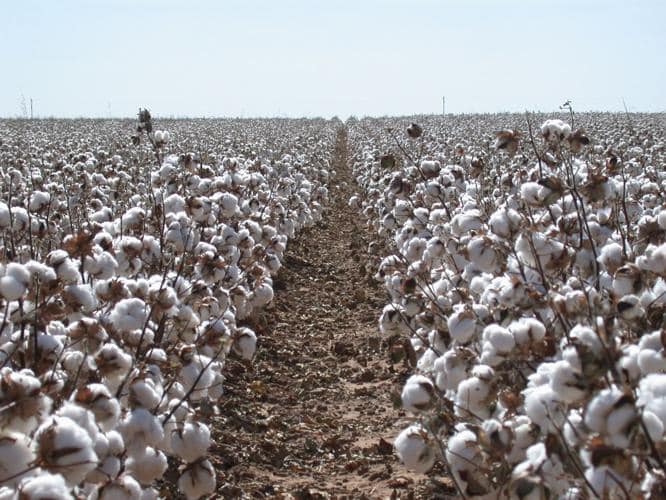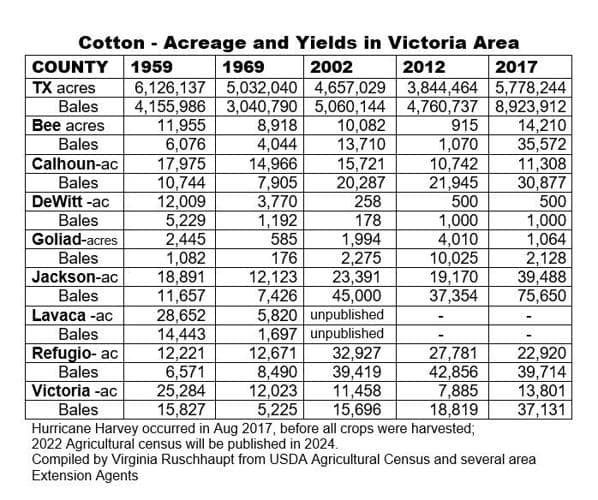COTTON: A stroll down memory lane – Gardeners’ Dirt by Virginia Ruschhaupt

CONTRIBUTED PHOTO: TAMU – Scientific advances have allowed cotton yields to increase.
Did you know Texas has a state fiber? Knowing the history of our great state, there is no doubt that would be cotton.
On June 18, 1997, the 75th Texas State Legislature designated cotton as the official state fiber and fabric. The resolution stated
“The state’s largest cash crop, cotton is planted on more acres than any other agricultural product in Texas, and the preeminence of the United States in world cotton production is due largely to the quantity produced within the state’s borders; the magnitude of this contribution is reflected in the fact that, if Texas were an independent country, it would rank sixth among the world’s cotton producers.”
That’s impressive.
Cotton is part of the mallow family. You can see its resemblance to hardy hibiscus. It is a perennial shrub grown as an annual and tilled back in the soil after harvesting to reduce pests.
Gossypium hirsutum, upland cotton, has relatively short fibers and is 97% of the U.S. cotton. The other 3%, Gossypium barbadense, an extra-long staple cotton, is used in the finest fabrics. Varieties include pima cotton that is grown in small quantities in West Texas
Cotton fiber is used for clothing, bedding, upholstery, carpet, personal care items and more. Even our currency is 75% cotton and 25% linen.
My memories of picking cotton as a child in the 50s and 60s in Lavaca County are not pleasant — the scorching sun, dragging a picksack, monotony of the same task day after day, and way too many black widow spiders.
Lavaca County cotton acreage was 28,000 in 1959. Today, grain and cattle occupy that full 28,000 acres. The Coastal Bend has seen ups and downs. Cotton farming has definitely changed.
Texas, growing cotton on 6 million acres, equivalent to 9,000 square miles, is the No.1 producer of cotton in the U.S. As of 2017, the economic impact of cotton and the products it creates was estimated at $24 billion annually for Texas.
Yields of upland cotton in Texas were 7.7 million bales at 480 pounds a bale in 2021, averaging 666 pounds per acre. Cotton yields vary each year depending on various challenges. Acreage has decreased, but thanks to scientific advancements, yields have increased.
The history of cotton includes slavery, the Civil War, share croppers, the cotton gin and subsequent inventions, government programs, global supply and demand. Mechanization has replaced small family farms and the picksack.
Scientific advancements include defoliation, seeds treated with fungicide and genetically enhanced seeds such as Roundup Ready. Plant growth regulators allow earlier harvests and fewer pests.
History of cotton is incomplete without the mention of two adversaries. Cotton root rot is a fungus that kills patches of cotton. It is prevalent in areas with hot summers and calcareous clay loam soils with pH of 7.0 to 8.5. Cotton is not the cause of cotton root rot, but is just one of the victims, including alfalfa, fruit trees, a total of 1,800 broad leafed plants.
The boll weevil made its debut in South Texas in 1894. Each female lays up to 200 eggs, each in a separate cotton boll. The boll then falls to the ground. Eggs hatch in three days to continue the cycle, causing the loss of $200 million annually by Texas cotton farmers.
Legislation in 1958 called for eradication of the boll weevil. Farmers, scientists, and the U.S. government cooperatively worked together in an unprecedented manner. They forged ahead regardless of setbacks. In 2009, the boll weevil was declared eradicated in the U.S. except for the Texas Rio Grande Valley.
Should we plant some cotton in our back yard, just for memories? Sorry, the Boll Weevil Eradication Equity Act prohibits that, and the Texas farmer thank you for saying ‘no.’
The Gardeners’ Dirt is written by members of the Victoria County Master Gardener Association, an educational outreach of Texas A&M AgriLife Extension – Victoria County. Mail your questions in care of the Advocate, P.O. Box 1518, Victoria, TX 77901; or [email protected], or comment on this column at VictoriaAdvocate.com.


More Cotton Facts
1. Spanish missions in San Antonio reported growing, spinning and weaving cotton as early as 1745.
2. Cotton is planted in February- April and harvested August-September in the Coastal Bend area. Yields vary depending on rainfall and irrigation. Most of the cotton in the Victoria area is not irrigated.
3. The South Plains area near Lubbock (27 counties) produces 64% of Texas cotton; however, San Patricio and Nueces counties are also significant producers.
4. Cotton seeds and oil separated from the lint are used for fertilizer, tires, cake and meal for cattle feed, and oil for cooking, paint, and lubricants.
REFERENCES
“The Accidental Gardener: If you are ‘cotton to’ grow cotton in your yard – read on”
Auburn University – ‘”What is a Boll Weevil?”
Barnhardt Natural Fibers – “Types of Cotton
“Cotton Counts” (several publications)
Dorsett, Jennifer, Texas Farm Bureau, “How is Cotton Harvested?”
The Historian, “Cotton Gin Facts and History – Have Fun With History”
Person, Janice, J Ploves Cotton LLC, “How is cotton picked Nowadays?” – blog –
Steadman, Jim, “Cotton Ginning Goes Bigger, Better, Faster”
Texas A&M AgriLife Extension Agents, Matt Bochat (Victoria County), Anthony Netardus (DeWitt), Brian Yanta (Goliad), Shannon Deforest (Lavaca)
TAMU – (Various information about cotton, includes many links)
TAMU – “Cotton in Texas – Crop Brief on Production, Pests, & Pesticides” –
TAMU -“Cotton Production Regions of Texas’ Cotton Insect Management Guide”
“Texas Counties: Cotton Produced in 2017”
USDA – Meyer, Leslie – “States Leading Cotton Production” (chart)
USDA Annual Crop Production – Jan. 12, 2023
Wagner, Frank – Texas State Historical Association, ‘Boll Weevil’